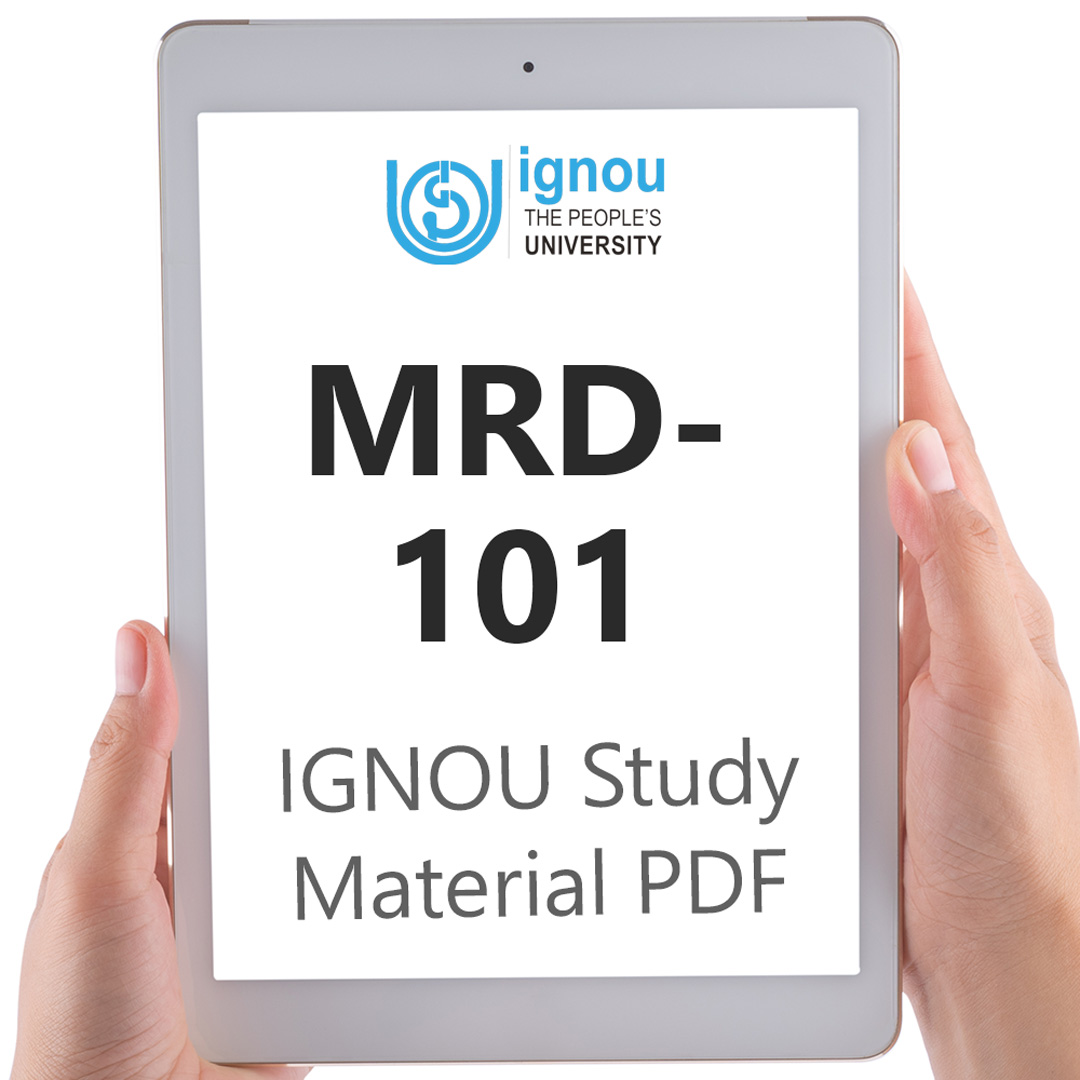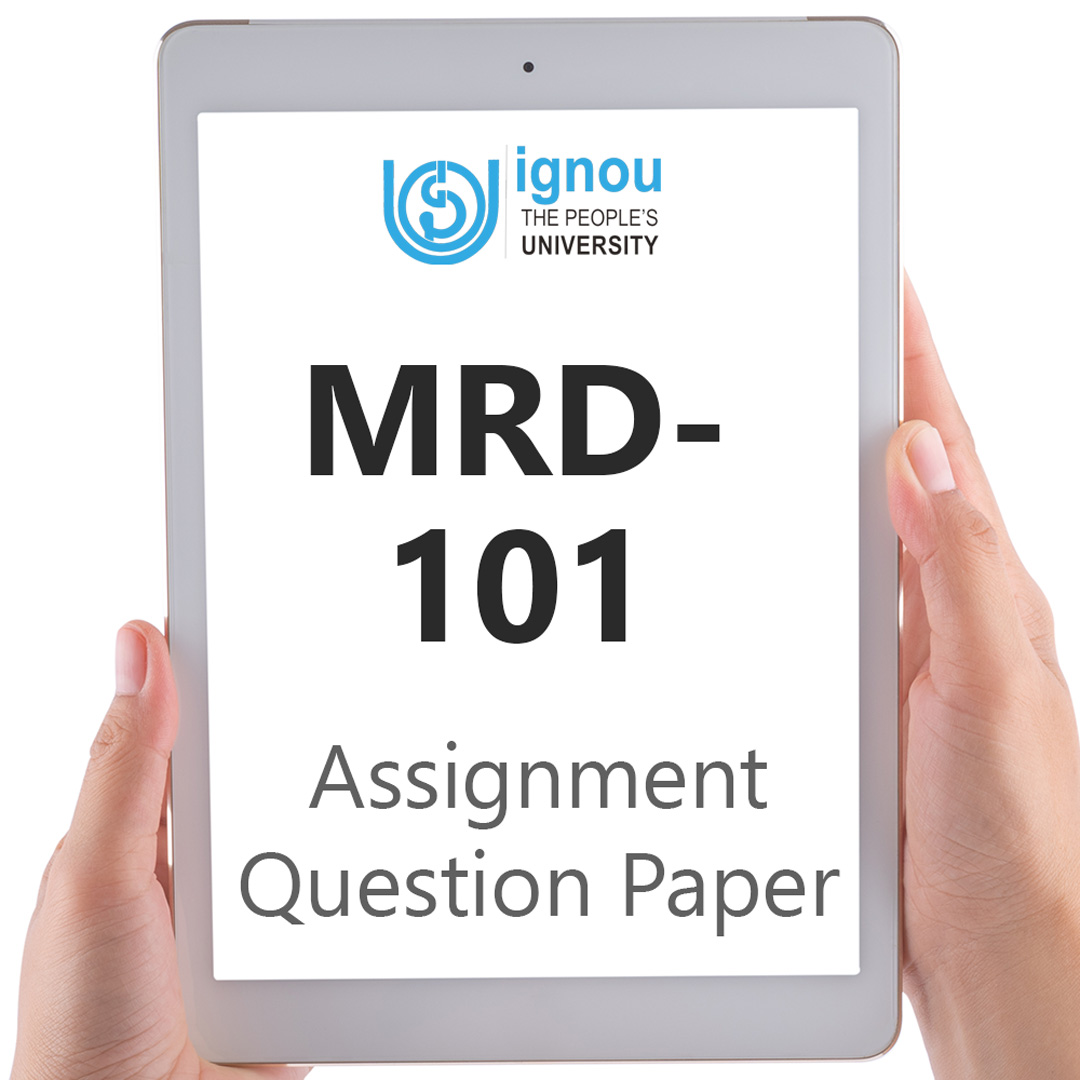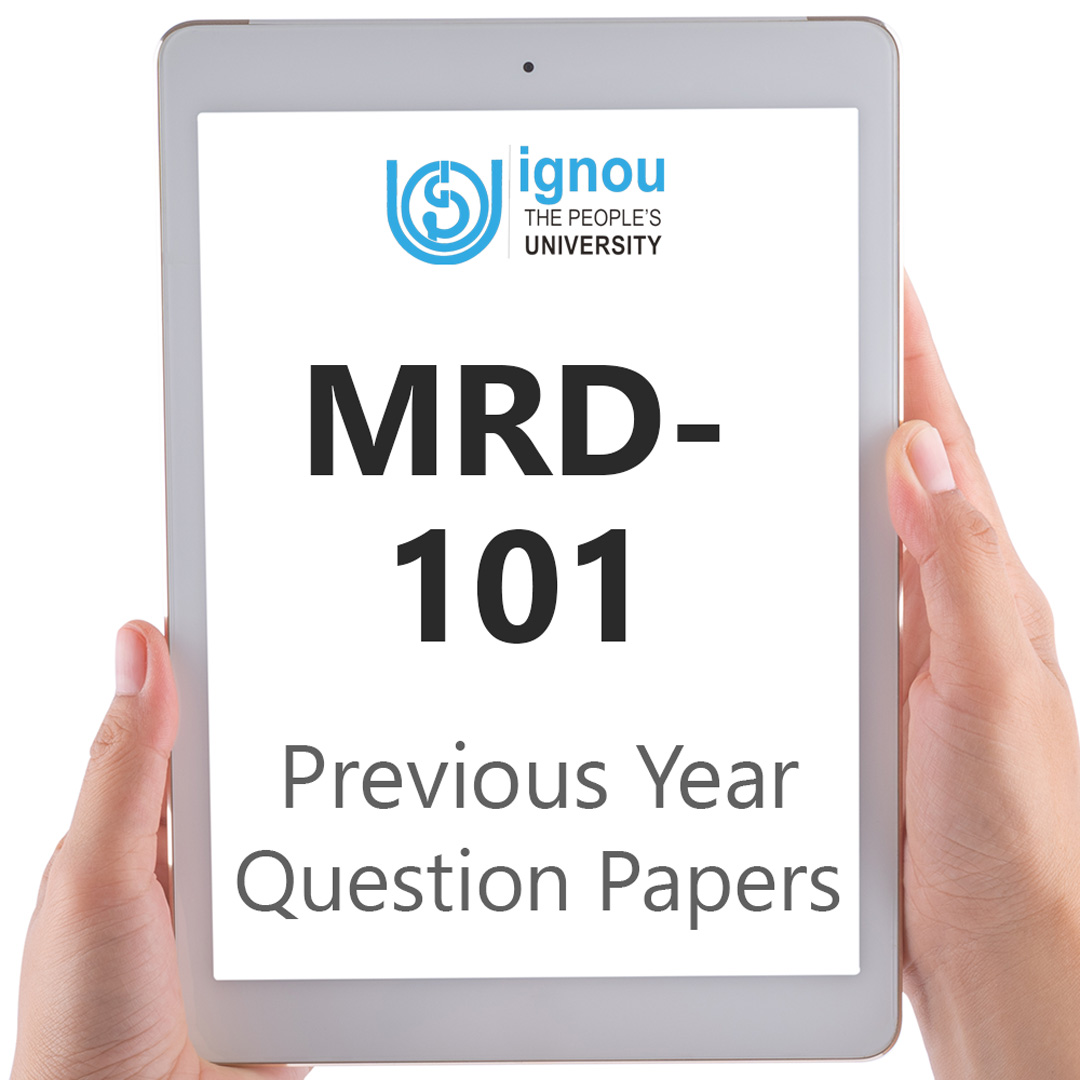If you are looking for MRD-101 IGNOU Solved Assignment solution for the subject Rural Development – Indian Context, you have come to the right place. MRD-101 solution on this page applies to 2022-23 session students studying in MARD, PGDRD, CRD courses of IGNOU.
MRD-101 Solved Assignment Solution by Gyaniversity
Assignment Code: MRD-101/TMA/2022-23
Course Code: MRD-101
Assignment Name: Rural Development: Indian Context
Year: 2022-2023
Verification Status: Verified by Professor
The assignment has three sections. It contains questions, which require long, medium, and short answers. A long answer should not exceed 1000 words. Medium answers should not exceed 500 words each. Short answers should not exceed 100 words each.
Long Answers Questions Maximum Marks
Attempt any One of the following: 40x1
Q1) What do you mean by empowerment? Explain the role of panchayats as an agent of political empowerment.
Ans) Empowerment is the power granted by one person or institution to another. The government can grant empowerment to a department to effect change, or a person can grant empowerment to her lawyer to sign contracts on her behalf.
This would imply that the term refers to the authority that can be granted to someone, a group of people, a society, or the government, depending on the circumstance. It is assumed that one group has power over another and can exert some sort of influence over the latter's choices or actions. Such control may be overt through coercion, direct physical control over financial resources, and the use of force, or it may be covert and subtle through psychological processes that affect the groups in such a way as to limit the range of options they perceive or enable them to perceive the options that are being offered as their own desires.
The majority of power writers want to see the transformation of power as more than merely a group of people giving up their positions of authority. This is due to the fact that if a section could grant power to someone else, it would follow that it could just as readily take it back. In this circumstance, "The Power Over" becomes illusory and would just continue to be an instrumentalist idea or rhetorical device rather than an active tool to bring about change that is just.
The underprivileged groups will only serve as a means to an end for development and advancement. Empowerment on the physical, social, and economic levels would result from this power dynamic. Although some people view a person's empowerment as giving them rights to make decisions and gaining self-reliance, it also implies the collective empowerment of marginalised groups.
Political Empowerment
India's government used a "top down" strategy to development during the first two decades of the country's independence by establishing a centrally planned economy in which all decisions on development up to the local level were made by the Planning Commission. Many infrastructure businesses, including steel factories, dams, and programmes for rural development, were put in place during the original planning years because they worked out successfully. However, despite their diversity, local populations' aspirations increased along with development. There was a widespread realisation that for plans to be successful, participation from the general public in decision-making was crucial.
Economic empowerment by itself cannot guarantee the ongoing growth and development of the underprivileged and weaker groups. Today, development is seen to be a participatory, people-centered process designed to bring about qualitative change in all facets of human life. The majority of its people experience both social and material growth through development in the modern setting, which must be a participatory process of social change that gives them more control over their surroundings.
Salient Features of Participatory Development
Participatory development would involve the following:
Grassroots community involvement in shaping development initiatives to meet local requirements.
Utilize technology that is cost- and labour-efficient and meets the needs of the rural community.
Create strong institutional frameworks at the community level to organise and carry out development programmes.
independently or with assistance from bureaucracy or NGOs, keep tabs on and assess how well the program's aims are being implemented.
Utilize the group energy of the rural community to implement social engineering, develop social assets, and increase community capacity.
Empowerment Through Self-Governance
Historically, Panchayats or local self-government in villages have always existed in India, albeit in various forms. Charles Metcalf referred to them as "Little Republics" with admiration. A decision to take action to establish elected local authorities for villages was adopted as early as the 24th session of the Congress Party in Lahore in 1909.
The Montague Chelmsford Reforms of 1919 called for the establishment of a hierarchical system with local delegates in charge of the upkeep and development of the village. However, the activity was not genuinely democratic because the majority of Panchayat representatives seized power based on their financial or landholding capabilities.
Before it gained traction and adopted the form of Panchayat Raj, Mahatma Gandhi's idea of "Gram Swaraj" with full authority endured vicissitudes. The Consultative Committee headed by Shri P.K. Thungam and the V.N. Gadgil Committee all took into consideration the many suggestions of the Ashok Mehta Committee, G.V.K. Rao Committee, and L.M. Singhvi Committee as well as the 1978 Sarkaria Commission Report.
The decisions made as a result of this exercise, which was conducted between 1985 and 1995, include: (a) giving a Panchayat constitutional recognition; (b) establishing a three-tier system of Zilla Parishad, Gram Sabha, and Panchayat; (c) granting a Panchayat a fixed term of five years; and (d) providing reservation for Scheduled Castes/Scheduled Tribes and at least 33 percent reservation for women.
Through the Constitution Act of 1992, Panchayat Raj was granted its current form. With effect from April 24, 1993, a notification brought this Act into force. Thus, democracy at the local level has been incorporated within the rights granted to Indian citizens by the Indian Constitution.
Article 245-I of the Constitutional Amendment of 1992 mandates the creation of a State Finance Commission in each State. These commissions are tasked with studying the issue of funding devolution to Panchayats and recommending solutions to the Governors.
Now, panchayats would organise and carry out social justice initiatives, economic development programmes, and other plans outlined in the Constitution's Eleventh Schedule. Program planning, monitoring, and evaluation will now be in the hands of the Panchayats.
Currently, the country is divided into 2.5 lakh Panchayats, 5906 intermediate Panchayats, and 500 district Panchayats, all of which are staffed by 29.2 lakh elected representatives.
States are allowed by the Constitution's Article 243-G to grant Panchayats the power and authority necessary to create plans for social justice and economic growth. States are allowed to provide grants-in-aid and other monies as needed, and Panchayats are permitted to levy the proper taxes, duties, tolls, and fees under Article 243-H.
For tribal areas in states like Andhra Pradesh, Bihar, Jharkhand, Gujarat, Himachal Pradesh, Maharashtra, Madhya Pradesh, Chhattisgarh, Orissa, and Rajasthan, the Provisions of Panchayats Act entered into force in 1996. The Act gives tribal organisations the power to determine their own course of action and to protect and safeguard their historical rights to natural resources.
Political empowerment is further aided by the country's decision to offer adult franchise to all citizens over the age of 18 without regard to their caste, religion, socioeconomic standing, or gender.
Medium Answers Questions Maximum Marks
Attempt any Two of the following: 15x2
Q1) Explain the development of cooperatives in India.
Ans) Numerous committees have periodically assessed the expansion and development of the cooperative movement in the nation and developed strategies to reduce inequities in that development. Here, we must remind you that cooperatives became a state topic in 1919 after the Cooperative Societies Act was passed. As a result, each state passed its own legislation with one another's help. The government, which also participates actively in this activity, gave its support for the cooperative movement to emerge in this nation. However, the regulations that the government created were limiting and were at odds with the ideas of collaboration.
Wherever there was more government equity, the movement did not flourish; nevertheless, where there was less government control, it thrived. For instance, the movement has made steady growth and government control has been reduced in the states of Gujarat and Maharashtra, where the governments had no stake in the equity of cooperatives. However, development was constrained in a number of other states, particularly in the North-East, Bihar, Uttar Pradesh, Rajasthan, Orissa, and Madhya Pradesh. Excessive government control through onerous legal restrictions and the lack of a clear cooperatives policy are the main causes of imbalances in the development of cooperatives.
The managing director, board of directors, and elected board of directors are all considered to be subordinate to the Registrar of a cooperative organisation, who also has the right to suspend and replace the elected board. Without autonomy, cooperatives would not have been able to hire skilled labour, build a professional image, or conduct business effectively. Second, because most of the operations that the cooperatives engaged in did not have profit margins, they were utilised as the governments' agents to carry out their policies, which did not aid in ensuring the cooperatives' viability.
But after the Multi State Cooperative Societies Act-2002, also known as the Reform Act, and parallel Acts were passed in nine states, including Andhra Pradesh, Bihar, Chhattisgarh, Delhi, Jammu & Kashmir, Karnataka, Madhya Pradesh, Orissa, and Rajasthan, the Registrar's authority was reduced to only registering, auditing, and scheduling timely Annual General Body Meetings. These changes will give cooperatives more freedom to operate independently, make their own plans, and manage their businesses hopefully successfully.
In addition, the ideology and guiding principles of cooperatives have finally been acknowledged, together with both their present and potential future roles in the process of global development, with the publication of the National Cooperative Policy in 2002. The movement will be able to actively contribute to the growth of the rural economy and actualize tremendous agricultural potential once these changes are adopted by all the states and cooperative policies are endorsed by all of them, which should greatly increase rural employment.
Q2) Discuss the process of economic and political empowerment of the rural poor.
Ans) The process of economic and political empowerment of the rural poor is as follows:
Economic Empowerment of the Rural Poor
Since independence, the National Agenda of Rural Reconstruction has included land reforms as a means of assisting the rural poor who lack access to land and lowering poverty. In an agrarian economy, land and ownership were the focal points of the entire village economy. Uneven land distribution and a tautological approach to rural development, which resulted in subpar programme performance, may be blamed for a large portion of the past uneasiness experienced by rural populations. Agrarian reform is necessary for rural development. Several plans and revisions by the government include:
Ownership rights are extended to tenant farmers. Up until 2001, 124.22 lakh tenants were protected.
The National Scheduled Caste and Scheduled Tribe Finance and Development Corporation was founded in 1989 and provides funding to state organisations that support the development of SCs and STs. In order to secure land for SC/ST tillers, it has started supporting the Land Purchase Scheme through NGOs, and it gives women the option of solo or joint ownership of all land.
It must be understood that the amount of land available for distribution keeps decreasing due to the rapid urbanisation and industrialization. According to a recent government survey, the majority of families possess less than one hector of land, making further subdivision and fragmentation impractical.
The SGSY aims to take the place of other cooperative self-employment initiatives that were tested effectively in a number of areas of the country from the 1930s to the 1960s but had gradually lost their appeal.
Political Empowerment of the Rural Poor
The importance of giving individuals from all social groups a sense of participation in decision-making if India is to become a multi-ethnic and multilingual country. For this reason, India chose to be a Republic with a Constitution that granted her inhabitants fundamental rights that were inalienable even as it adopted the Westminister Model of Parliament. She granted herself a powerful judiciary as a forerunner of her citizens' rights, as well as universal suffrage regardless of caste, faith, race, gender, or degree of literacy, and the one-man, one-vote premise.
India's government used a "top down" strategy to development during the first two decades of the country's independence by establishing a centrally planned economy in which all decisions on development up to the local level were made by the Planning Commission. Many infrastructure businesses, including steel factories, dams, and programmes for rural development, were put in place during the original planning years because they worked out successfully. However, despite their diversity, local populations' aspirations increased along with development. There was a widespread realisation that for plans to be successful, participation from the general public in decision-making was crucial.
Economic empowerment by itself cannot guarantee the ongoing growth and development of the underprivileged and weaker groups. The majority of its people experience both social and material growth through development in the modern setting, which must be a participatory process of social change that gives them more control over their surroundings.
Short Answers Questions Maximum Marks
Write short notes on any Five of the following: 6x5
Q1) Village Knowledge Centre
Ans) Village Knowledge Centres serve as information dissemination centre providing instant access to farmers to latest information/ knowledge available in the field of agriculture, starting from crop production to marketing. Every VKC is manned by a “VKC In-charge” who looks after the operations of the VKC. VKCs also work towards the development of the rural community. So, in addition to information, training in things such as dairy improvement, clean milk production, etc is given to the farmers. Special help to heavily indebted farmers is provided so that they enjoy financial freedom. Villagers also consider this as a symbol of status and utilize the knowledge provided through VKCs.
Q2) Little and Great Traditions
Ans) Little tradition consists of local customs, rites, rituals, dialects and Great tradition contains legitimate form of all these things. McKim Marriot found that when little tradition and Great tradition interact with each other two types of movements are observed—upward and downward. Little tradition and Great tradition interacts with each other and also these two are interdependent in India. The concepts of universalization and parochialisation also describe the process of cultural change implied by Sanskritisation, specially universalisation comes very close to the concept. Some of the social scientists feel that Indian society or culture could not be described fully with the help of little tradition and Great tradition.
Q3) Barriers to Communication
b) A communication barrier is anything that comes in the way of receiving and understanding messages that one sends to another to convey his ideas, thoughts, or any other kind of information. These various barriers of communication block or interfere with the message that someone is trying to send. There are numerous barriers to effective communication that can come in the way. It happens because the message sent by the sender might not be understood exactly as it is meant to be. It can get distorted during the communication exchange. These different types of communication barriers can come at any stage in the process of communication.
Q4) Grameen Bank
Ans) In 1983, the Grameen Bank was established as a public sector lending organisation with the goal of providing credit to rural landless people and those with holdings of less than 0.5 acres. A field manager oversees each GB branch while a team of band employees provide the banding services. Five potential loan recipients are organised into a group with the help of the BWs, and several groups in the same area are united to establish a centre. Weekly meetings are led by the elected centre chief, who also suggests loan requests. The organisation has a group fund and an emergency fund that allow for borrowing in an emergency and for repaying a deceased member's loan.
Q5) Cultural Empowerment
Ans) The broad field of "cultural empowerment" focuses on the beliefs, values, language, art, and rituals that define a community. The empowering process is slowed down by the "cultural lag," which is the longer time it takes for cultural mores to shift. An outstanding example of a group that has to be protected from exploitation and allowed to participate in economic and political life while maintaining their cultural traditions, art, and craft is the tribal people. This is because it is understood that many tribal societies do not practise extensive discrimination based on gender or caste and that preserving the positive aspects of tribal culture can be beneficial to the society as a whole.





